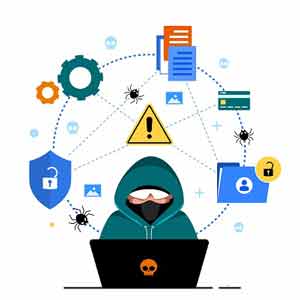Hack-Proof Your Business: Cyber Security Services Explained
- November 25, 2023
- Posted by: admin
- Category: Cyber Security
Introduction to Cyber Security Services
In today’s digital landscape, safeguarding business assets from cyber threats is paramount. Cybersecurity services encompass a range of strategies, technologies, and practices designed to protect systems, networks, and data from unauthorized access, attacks, and damage.

Importance of Cyber Security
Cyber security is vital as it shields sensitive information, mitigates risks, ensures regulatory compliance, and sustains business continuity. With the increasing reliance on technology, the exposure to cyber threats amplifies, underscoring the critical role of cyber security services in safeguarding digital assets.
Types of Cyber Security Services
- Network Security
Network security involves securing computer networks from unauthorized access or breaches. It encompasses firewalls, intrusion detection systems, VPNs, and other mechanisms to protect against cyber attacks on network infrastructure.
- Endpoint Security
Endpoint security focuses on securing individual devices or endpoints like computers, smartphones, and tablets. It includes antivirus software, encryption, and application control to defend against malware and other threats.
- Cloud Security
Cloud security safeguards data stored in cloud platforms by implementing security protocols, encryption, access controls, and monitoring to prevent data breaches or unauthorized access.
- Application Security
Application security involves securing software and applications from vulnerabilities that hackers could exploit. It includes code reviews, penetration testing, and implementing security measures during the development phase.
Understanding Cyber Threats
Cyber threats come in various forms, including malware, phishing, ransomware, and social engineering. Hackers exploit vulnerabilities to gain access to sensitive information or disrupt operations.
Absolutely! Understanding cyber threats is crucial in today’s digital age. Cyber threats refer to malicious activities aimed at disrupting, damaging, or gaining unauthorized access to computer systems, networks, or data.
-
Malware:
Malware, short for malicious software, refers to any software intentionally designed to cause damage, gain unauthorized access, or disrupt computer systems, networks, or devices. It is created by cybercriminals with malicious intent to compromise the confidentiality, integrity, or availability of data, systems, or networks.
Here are some common types of cyber threats:
-
- Viruses: Programs that replicate themselves by attaching to other files or programs and spread across systems, often causing damage or stealing data.
- Worms: Self-replicating malware that spreads across networks without user intervention, exploiting vulnerabilities to infect multiple devices.
- Trojans: Malware disguised as legitimate software to deceive users into installing it. Trojans can create backdoors, steal data, or provide unauthorized access to attackers.
- Ransomware: Malware that encrypts files or locks users out of their systems, demanding a ransom for decryption or restoring access.
- Spyware: Malicious software that secretly gathers information about a user’s activities, including keystrokes, browsing habits, and sensitive data, and sends it to third parties.
- Adware: Software that displays unwanted advertisements or redirects users to malicious websites, often disrupting user experience or compromising system security.
Malware can infect devices through various means, such as email attachments, infected websites, removable media, or software vulnerabilities. Prevention and mitigation of malware involve using antivirus software, regularly updating systems and applications, being cautious of suspicious emails or links, and practicing safe browsing habits to minimize the risk of infection.
-
Phishing:
Phishing is a type of cyber attack where attackers use deceptive tactics to trick individuals into divulging sensitive information, such as passwords, credit card numbers, or personal data. This is typically done by masquerading as a trustworthy entity through emails, text messages, or fake websites.
The goal of phishing is to manipulate recipients into believing the communication is from a legitimate source, like a bank, government agency, or reputable company. Attackers often create a sense of urgency or fear to prompt immediate action, such as clicking on a link, downloading an attachment, or providing confidential information.
Common phishing techniques include:
-
- Email Phishing: Sending fraudulent emails that appear to be from a legitimate source, requesting personal information or directing users to fake websites to steal their credentials.
- Spear Phishing: Tailoring phishing attacks to target specific individuals or organizations by using personalized information to increase credibility and deceive the recipient.
- Vishing (Voice Phishing): Using phone calls to deceive individuals into providing sensitive information or directing them to call a fraudulent number to extract data.
- Smishing (SMS Phishing): Sending text messages with deceptive content, often containing links or instructions to lure recipients into providing information or downloading malware.
To protect against phishing attacks, individuals should:
-
- Verify the authenticity of emails or messages by checking sender details and URLs.
- Avoid clicking on suspicious links or downloading attachments from unknown sources.
- Be cautious of urgent or alarming messages that demand immediate action.
- Use security measures like two-factor authentication and up-to-date antivirus software.
- Educate themselves and their teams about phishing techniques to recognize and report suspicious activities.
By staying vigilant and adopting cybersecurity best practices, individuals and organizations can reduce the risk of falling victim to phishing scams and protect their sensitive information from being compromised.
-
DDoS Attacks:
DDoS stands for Distributed Denial of Service, which refers to a type of cyber attack aimed at disrupting the normal functioning of a network, service, or website. In a DDoS attack, multiple compromised systems, often infected with malware and controlled by the attacker (known as a botnet), flood the targeted system with an overwhelming volume of traffic or requests.
The main characteristics of a DDoS attack include:
-
- Distributed Nature: DDoS attacks involve a multitude of devices or computers, often spread across different locations, generating a massive amount of traffic simultaneously.
-
- Denial of Service: The attack’s primary objective is to render the targeted network, server, or service unavailable to legitimate users by flooding it with excessive traffic, causing a disruption in its normal operations.
DDoS attacks can be executed in various ways:
-
- Volume-Based Attacks: Overwhelm the target with a high volume of traffic, consuming its bandwidth and resources, making it inaccessible to legitimate users.
- Protocol Attacks: Exploit vulnerabilities in network protocols to disrupt the target’s normal operations.
- Application Layer Attacks: Target specific applications or services, exhausting their resources and rendering them unusable.
Mitigating DDoS attacks involves employing various strategies:
-
- Traffic Filtering: Implementing traffic filtering techniques to identify and block malicious traffic.
- Content Delivery Networks (CDNs): Using CDNs to distribute traffic and absorb attack volume.
- Scaling Infrastructure: Ensuring systems and networks are capable of handling increased traffic during an attack.
- DDoS Protection Services: Utilizing specialized DDoS protection services or appliances to detect and mitigate attacks.
The goal of DDoS attacks varies; it can be to disrupt services, cause financial harm, or act as a distraction while another cyber attack takes place. Organizations often implement robust security measures and monitoring systems to detect and mitigate these attacks to minimize disruptions and maintain their online services’ availability.
-
Man-in-the-Middle Attacks:
Man-in-the-Middle (MitM) attacks are a type of cyber attack where a malicious actor intercepts communication between two parties without their knowledge. In this attack, the attacker positions themselves between the sender and receiver, allowing them to eavesdrop on, alter, or manipulate the communication flowing between the two legitimate parties.
Here’s how a Man-in-the-Middle attack typically works:
-
- Interception: The attacker gains access to the communication channel between two parties, such as between a user and a website, by exploiting vulnerabilities in the network or using deceptive methods.
- Monitoring or Modification: Once the attacker has intercepted the communication, they can monitor the traffic to gather sensitive information or modify the data exchanged between the parties. This can include stealing login credentials, injecting malware, or altering the content of messages.
- Relaying Information: In some cases, the attacker may also relay information between the legitimate parties, making it appear as if the communication is direct when, in fact, it passes through the attacker’s system.
Man-in-the-Middle attacks can occur in various scenarios, including:
-
- Public Wi-Fi Networks: Attackers can exploit insecure public Wi-Fi connections to intercept traffic between users and websites/applications.
- DNS Spoofing: Manipulating the Domain Name System (DNS) to redirect users to fraudulent websites or servers controlled by the attacker.
- Session Hijacking: Taking control of an ongoing communication session between two parties, such as a user’s active session on a website.
To mitigate Man-in-the-Middle attacks, several measures can be taken:
-
- Encryption: Using encryption protocols (like HTTPS, SSL/TLS) for secure communication to prevent eavesdropping or data tampering.
- Network Security: Implementing strong network security measures, such as firewalls and intrusion detection systems, to detect and prevent unauthorized access.
- Public Wi-Fi Awareness: Being cautious while using public Wi-Fi networks and avoiding sensitive transactions on unsecured connections.
- Digital Certificates: Verifying digital certificates to ensure the authenticity of websites and the integrity of communications.
By implementing these security practices and remaining vigilant, individuals and organizations can reduce the risk of falling victim to Man-in-the-Middle attacks and protect the confidentiality and integrity of their communication channels.
-
Social Engineering:
In today’s interconnected world, cybersecurity threats have evolved beyond technical breaches. Social engineering, a psychological manipulation technique, has emerged as a significant threat to individuals and organizations alike.
Types of Social Engineering Attacks
Social engineering encompasses various attack vectors that exploit human behavior for malicious purposes.
-
- Phishing : One of the most common tactics involves sending deceptive emails or messages, masquerading as legitimate entities, to trick individuals into revealing sensitive information such as passwords or financial details.
- Pretexting : This involves creating a fabricated scenario to gain a person’s trust, often through impersonation or providing false information, to extract valuable data.
- Baiting: Malicious actors offer tempting incentives, such as free downloads or USB drives containing malware, to lure victims into compromising their security unknowingly.
- Tailgating: Physical infiltration into secure areas by closely following authorized personnel or using social skills to gain unauthorized access.
- Quid Pro Quo: Perpetrators offer something desirable in return for valuable information, exploiting the victim’s willingness to exchange data for perceived benefits.
- Impersonation:Posing as authority figures, co-workers, or acquaintances to gain trust and extract sensitive information or unauthorized access.
Tactics Used in Social Engineering
Social engineering relies on manipulating human psychology and employing deceptive techniques to exploit vulnerabilities rather than technical weaknesses.
The perpetrators exploit psychological traits like trust, curiosity, and authority to persuade individuals to act against their better judgment. These techniques involve careful planning, research, and tailoring methods to the target.
Impact of Social Engineering Attacks
The consequences of falling victim to social engineering attacks can be severe, leading to data breaches, financial losses, and reputational damage.
Data breaches can result in the exposure of sensitive information, leading to identity theft or unauthorized access to confidential data. Financial losses may occur due to fraudulent transactions or business email compromise scams. Moreover, organizations can suffer reputational damage, eroding trust among customers and stakeholders.
Preventive Measures Against Social Engineering
Mitigating social engineering threats requires a multi-faceted approach involving education, technology, and proactive measures.
Training employees to recognize and report suspicious activities, implementing stringent security protocols, employing multifactor authentication, and devising an effective incident response plan are crucial steps in fortifying defenses against social engineering attacks.
-
Zero-day Exploits:
Zero-day exploits refer to vulnerabilities in software or hardware that are unknown to the vendor or developers, leaving systems susceptible to attack. These vulnerabilities are called “zero-day” because, at the time of exploitation, there are zero days of defense or fixes available. Essentially, attackers take advantage of these vulnerabilities before the developers can create patches or updates to fix them.
Zero-day exploits can be highly dangerous because there’s no prior knowledge or defense against them. Attackers can use these vulnerabilities to gain unauthorized access to systems, steal sensitive data, install malware, or conduct other malicious activities.
Once a zero-day vulnerability is discovered, software developers work swiftly to create patches or updates to mitigate the risk. However, until the patch is widely distributed and applied by users, systems remain vulnerable.
Security researchers, cybercriminals, and government entities often hunt for zero-day vulnerabilities. While ethical researchers report them to the respective vendors for fixing, cybercriminals exploit them for nefarious purposes. Consequently, zero-day exploits represent a significant challenge in the cybersecurity landscape, necessitating constant vigilance, rapid response, and proactive security measures to mitigate their impact.Attacks that target vulnerabilities unknown to the software developer or vendor, leaving systems susceptible to attack.
Insider Threats:
Insider threats in cybersecurity refer to risks posed to an organization’s security by individuals within the organization, such as employees, contractors, or partners, who misuse their access, knowledge, or privileges to compromise security. These threats can be intentional or unintentional and pose significant risks to data, systems, and sensitive information.
Types of Insider Threats:
-
- Malicious Insiders: These are individuals who intentionally misuse their access rights for personal gain, revenge, or to cause harm to the organization. They might steal sensitive data, sabotage systems, or carry out fraudulent activities.
- Careless or Negligent Insiders: This category includes employees who unintentionally compromise security due to carelessness, lack of awareness, or failure to follow security protocols. Actions like clicking on phishing emails, using weak passwords, or mishandling sensitive information can lead to security breaches.
- Compromised Insiders: Sometimes, employees’ credentials or access rights can be compromised by external actors through phishing, social engineering, or malware. These compromised individuals unknowingly become vehicles for cyberattacks within the organization.
- Disgruntled Insiders: Employees who feel aggrieved, overlooked, or dissatisfied with the organization may resort to malicious actions. Their motivation might stem from a sense of revenge, causing damage to the company’s reputation, or disrupting operations.
Mitigating Insider Threats:
Employee Training and Awareness: Regular cybersecurity training sessions to educate employees about the risks of insider threats, how to identify suspicious activities, and the importance of following security protocols.
-
- Access Control and Monitoring: Implementing strict access controls, limiting privileges based on roles, and monitoring user activities to detect unusual behavior or access patterns.
- Strong Authentication and Encryption: Enforcing strong authentication methods (like multi-factor authentication) and encrypting sensitive data to prevent unauthorized access.
- Regular Security Audits: Conducting regular security audits and assessments to identify vulnerabilities, review access logs, and ensure compliance with security policies.
- Establishing a Positive Work Environment: Fostering a positive workplace culture that encourages open communication, addresses grievances, and reduces the likelihood of disgruntled employees resorting to malicious actions.
Insider threats can be challenging to detect and prevent, as they often involve individuals with legitimate access to systems and information. Organizations must adopt a layered approach to cybersecurity, combining technology, policies, and employee education to effectively mitigate the risks posed by insider threats.
Understanding these threats is essential for implementing robust cybersecurity measures, such as:
-
- Firewalls and Antivirus Software: Protect systems from unauthorized access and detect/remove malicious software.
- Regular Updates and Patching: Ensuring software, applications, and systems are up-to-date to fix vulnerabilities.
- Strong Authentication: Implementing multi-factor authentication to enhance login security.
- Employee Training: Educating staff about cyber threats, phishing emails, and best practices for data security.
- Data Encryption: Securing sensitive information to prevent unauthorized access even if intercepted.
Cyber threats constantly evolve, so staying informed, proactive, and regularly reassessing security measures is crucial to mitigate risks and protect against potential cyber attacks.


